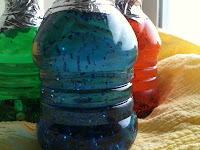When I spotted the hula hoop in the store, I knew I had to get it and create a class around it. This led me on a hunt to find just the right circus book to create the next story dance class. Surprisingly, I had a pretty hard time finding a usable circus book. I went to libraries and books stores, and no one seemed to carry anything I could use. I looked online and saw some books, but did not have the option of picking them up and looking through them to see if they were just right for the class. So I decided to take my chances with what I could see online. I ordered Circus by Lois Ehlert and it worked out great for Story Story Dance.
During the reading of the book the children were elated. They responded with
oohs and
ahhhs and applause for each page. The colors are vibrant and there are many shapes throughout the text that I could stop and ask,
what shape is this? It worked out great. We even acted out eating the snacks during the intermission. The only thing that seemed to be missing from the story was jugglers. Though they did not appear in the story, I took out the scarves at the end of one of the classes and added the
juggling element. The children and I threw the scarves back and forth to each other to the music, and it was super fun.
We acted out movements based on the characters and events in the story. Since we became the circus performers, we ended class by attending the "cast party" and free danced for the end of class:
·
World’s Biggest Elephant – Elephant breath
·
Ride on the prancing horse -Gallop
·
Walk the high wire - Walk across rope, or tape, as the high wire
·
Human Pretzel – Link arms
·
Flaming Hoop/Fearless Leaping Lizards - Jump through the hula
hoop.
·
Marching Snakes – Belly crawl “marching”
·
Whistle Twinkle Twinkle – Use this as a rest, sit on bottoms
and whistle/hum the tune.
·
Head in a Lion’s Mouth – Act out
·
A Big Hand – Everyone applauds












